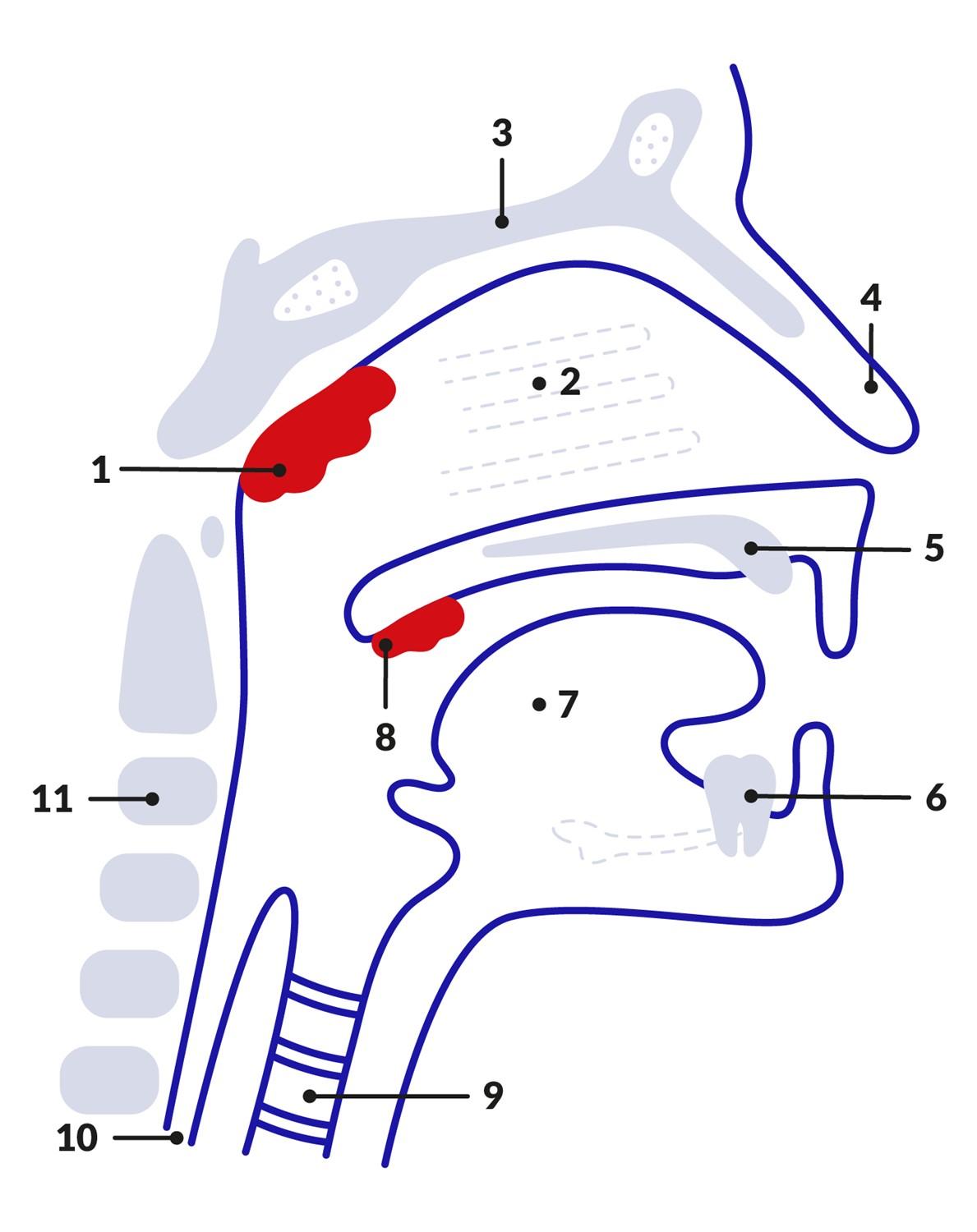
What do tonsils do?
Peer reviewed by Dr Helen Huins, MRCGPLast updated by Dr Mary Harding, MRCGPLast updated 31 May 2018
- DownloadDownload
- Share
The main function of tonsils is to trap germs (bacteria and viruses) which you may breathe in. Proteins called antibodies produced by the immune cells in the tonsils help to kill germs and help to prevent throat and lung infections.
In this article:
Continue reading below
What are adenoids and tonsils?
Tonsils
Tonsils are lumps of soft tissue and are part of the immune system. You have two tonsils, one on either side at the back of the mouth.
Tonsils vary in size from person to person.
You can normally see your tonsils by opening your mouth wide and looking in a mirror. They are the two fleshy lumps that you can see at the sides and back of the mouth.
Mouth and nasal passage

Adenoids
Adenoids are made of similar tissue and are part of the immune system. They hang from the upper part of the back of the nasal cavity (see diagram).
Adenoids get bigger after you are born but usually stop growing between the ages of 3 and 7 years.
You cannot see your adenoids. If needed, a doctor can look at the adenoids either by using a light and a small mirror held at the back of the mouth, or by using a small flexible telescope. Occasionally, an X-ray is done to determine the size of the adenoids.
Like tonsils, adenoids help to defend the body from infection. They trap bacteria and viruses which you breathe in through your nose. They contain cells and antibodies of the immune system to help prevent throat and lung infections.
Although tonsils and adenoids may help to prevent infection, they are not considered to be very important. The body has other means of preventing infection and fighting off bacteria and viruses. In fact, the adenoids tend to shrink after early childhood and by the teenage years they often almost disappear completely. Generally, you can have your tonsils and adenoids removed without increasing your risk of infection.
Some problems associated with tonsils
Tonsillitis
Tonsillitis is an infection of the tonsils. A sore throat is the common symptom. In addition, you may also have:
A cough.
A high temperature (fever).
A headache.
Pain on swallowing.
Tiredness.
A feeling of wanting to be sick (nausea).
Swollen neck glands.
Pus may appear as white spots on the enlarged tonsils. Symptoms typically get worse over 2-3 days and then gradually go, usually within a week. Most cases of tonsillitis are caused by viruses, some are caused by germs (bacteria). See the separate leaflet called Tonsillitis for more details.
Glandular fever (infectious mononucleosis)
Infectious mononucleosis is caused by the Epstein-Barr virus. It tends to cause a severe bout of tonsillitis in addition to other symptoms. See the separate leaflet called Glandular Fever (Infectious Mononucleosis) for more details.
Quinsy
This is also known as peritonsillar abscess. An abscess is a collection of pus. Quinsy is an uncommon condition where an abscess develops next to a tonsil, due to a bacterial infection. It usually develops just on one side. It may follow an episode of tonsillitis or may arise on its own. The tonsil on the affected side may be swollen or look normal. However, it is pushed towards the midline as pus forms and the abscess next to the tonsil gets bigger and bigger. Quinsy is very painful and can make you feel very unwell. It is treated with antibiotic medicines; however, the pus also often needs to be drained with a small operation.
Cancer of the tonsil
This is a rare cancer. It is more common in smokers and those who drink a lot of alcohol.
Continue reading below
Do I need my tonsils taken out?
You may be advised to have your tonsils removed in certain situations. In particular:
If you have frequent and severe bouts of tonsillitis. This usually means:
Seven or more episodes of tonsillitis in the preceding year; or
Five or more such episodes in each of the preceding two years; or
Three or more such episodes in each of the preceding three years; and
The bouts of tonsillitis affect normal functioning. For example, they are severe enough to make you need time off from work or from school.
The adenoids may also be removed at the same time for this reason. Throat infections are not totally prevented if the tonsils are removed. However, there is a good chance that their number and severity will be reduced. Also, the risk of developing quinsy is reduced. Many people say they generally feel better in themselves after having their tonsils removed if they previously had frequent bouts of tonsillitis.If you have large tonsils that are partially obstructing your airway, this may be a contributing factor to a condition called obstructive sleep apnoea syndrome. See the separate leaflet called Obstructive Sleep Apnoea for more details.
If you develop cancer of the tonsil.
Some problems associated with adenoids
Swollen or enlarged adenoids are common in children. Causes include:
Infections with germs (viruses or bacteria). Once an infection clears, the swelling often goes down but sometimes the adenoids remain enlarged.
Allergies.
Often there is no apparent cause.
Continue reading below
What are the symptoms of swollen, enlarged adenoids?
Swollen adenoids may not cause any symptoms or problems. However, symptoms may develop in some cases, especially if the adenoids become very large. Possible symptoms include the following:
Breathing through the nose may be noisy or rattly. This may become worse and cause difficulty breathing through the nose. The child then mainly mouth breathes.
A constantly runny nose.
Snoring at night. In severe cases sleep may be disrupted by the blocked nose and there is difficulty with breathing.
Swollen adenoids may block the entrance of the Eustachian tube. This is the tube that goes from the back of the nose to the middle ear. It normally allows air to get into the middle ear. If this tube is blocked it may contribute to the formation of glue ear (fluid in the middle ear). See the separate leaflet called Glue Ear for more details.
What is the treatment for enlarged adenoids?
In most cases no treatment is needed. Often the symptoms are mild but may flare up during a cold or throat infection. Adenoids normally gradually shrink in later childhood and usually almost disappear by the teenage years. So symptoms tend to clear with time.
If symptoms are severe then a doctor may consider removing the adenoids. For example, if a child regularly has difficulty sleeping or disrupted night-time sleep due to a blocked nose. Also, some children with glue ear may benefit from removal of their adenoids.
A note about removing the tonsils and/or adenoids
Several years ago, operations to remove tonsils and adenoids were very common. These operations are done less commonly these days and the main indications for them being advised are discussed above. As with all operations, there is a risk involved with surgery.
For example, possible complications of surgery include infection, severe bleeding from the sites where the tonsils or adenoids were removed, and anaesthetic reactions. Also, after adenoids are removed, there is a small risk that speech may become nasal. That is, a child may sound as if they are speaking through their nose. This is because after the adenoids are removed, the gap between the back part of the nose cavity and the roof of the mouth may not close properly, as it should do when we talk. If this occurs, it may only be temporary. However, in a small number of cases speech therapy is needed, or even an operation to narrow the gap.
The amount of benefit gained from having tonsils and/or adenoids removed is not clear. It is a painful operation to recover from. Therefore, before you (or your child) have the operation, it is useful to discuss with the surgeon the benefits versus the risks of the operation. If you choose to have the operation, your hospital will provide more information about the specifics of the procedure and recovery. See also the separate leaflet called Tonsillectomy for more information.
Continue reading below
Article history
The information on this page is peer reviewed by qualified clinicians.
31 May 2018 | Latest version

Book a free same day online consultation
Get help with common conditions under the NHS Pharmacy First scheme.

Feeling unwell?
Assess your symptoms online for free